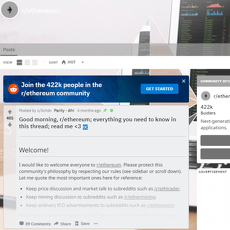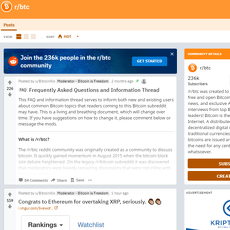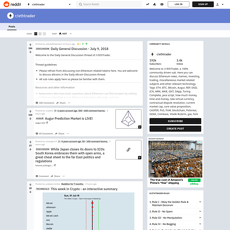r/BitcoinMarkets Review
r/BitcoinMarkets
www.reddit.com
r/BitcoinMarkets Review Guide: Everything You Need to Know + FAQ
Ever open r/BitcoinMarkets, see ten charts pointing in twelve directions, and wonder which one actually matters for your trade?
You’re in the right spot. I’m going to show you how to use this Reddit community to sharpen your reads, cut through noise, and ask questions that get real answers. If you want cleaner trading ideas, smarter macro context, and a place to sanity-check your Bitcoin thesis without wasting your weekend scrolling, this guide will help.
Think of it like a trader’s map for Reddit. No fluff, no hype—just a clear way to turn that subreddit into an actual edge.
The common struggles on r/BitcoinMarkets
Let’s be honest: it’s easy to get lost. The feed moves fast, opinions conflict, and the quality bar swings hour by hour. If you’ve felt any of these, you’re not alone:
- Signal vs. noise feels rough. One post swears a macro breakdown is “imminent,” the next shows a clean 4H trend continuation. Which one do you trust?
- Thread etiquette trips people up. New users often post standalone questions that belong in the daily thread and get removed by mods.
- Charts without context. A beautiful chart with no timeframe, invalidation, or levels is just a picture, not a plan.
- Chasing hot takes. Fast-moving headlines (CPI, ETF flows, funding spikes) can push you into reactive trades.
- Decision fatigue. Too many tabs, too many indicators, not enough clarity.
Real example: “Is this a bull flag on the 4H?”—with no chart attached. Or a TA screenshot that never mentions bias or invalidation. These get ignored or removed—and for good reason.
There’s also a human bias element here. Research on retail trading communities shows that social proof can amplify overconfidence and herding—great for momentum, not so great for risk. If you’re curious, take a look at findings like Barber & Odean’s classic work on overtrading reducing returns, or broad herding research summarized by Bikhchandani & Sharma. Those lessons show up on Reddit every week.
What I’ll solve for you in this guide
I built this guide to make r/BitcoinMarkets work for you—not the other way around. Here’s what I’ll help you with:
- What the sub actually is and what belongs there (versus general Bitcoin chatter).
- Which threads matter daily so you don’t miss the good stuff or get posts removed.
- How to spot quality TA/FA—and skip low-effort, high-confidence guesses.
- Etiquette that gets responses, not silence (or mod pings).
- A practical filter system so you only see posts that fit your strategy and timeframe.
Quick win you can apply immediately: when you scan the sub, ask of any chart, “What’s the bias? What level invalidates it? What timeframe is this?” If those aren’t obvious, keep scrolling.
Who this review is for, and what to expect
Whether you’re a long-term Bitcoin holder, an active trader, or just getting started, this guide is built to match how you learn:
- BTC-only holders: Get a macro-first way to read the room and stress-test your thesis without reacting to every hourly swing.
- Active traders: Find consistent, higher-signal posts and frameworks that translate into entries, exits, and risk—not just nice screenshots.
- Curious beginners: Learn the etiquette, threads, and simple checks that keep you from getting overwhelmed. You’ll ask better questions and get better help.
You’ll see real examples, tactical tips, and quick prompts you can use in your next scroll. This is educational, not financial advice—use it to build your own process.
Ready to make r/BitcoinMarkets actually useful? In the next section, I’ll show you exactly what the sub is (and how it’s different from the others) so you can start filtering like a pro. Curious which daily threads are worth your time—and which aren’t?
What r/BitcoinMarkets is (and how it’s different)
r/BitcoinMarkets is where Reddit talks Bitcoin price, not Bitcoin philosophy. Think charts, liquidity, order books, derivatives, ETF flows, and macro fuel—without the meme spam. The tone skews analytical and practical. If you want signal around BTC’s trend, levels, and catalysts, this is the room you keep open while the market moves.
“Your edge is curation, not prediction.”
If you’ve ever felt buried under takes that don’t line up with your strategy, this community trims the fluff. The posts that stick are the ones that show work: chart, timeframe, levels, reasoning, and an “I’m wrong if…” line.
What you’ll find here daily
Most days look like this: a rolling discussion thread and a steady flow of BTC-focused market reads. Expect:
- Charts with context: Higher-timeframe support/resistance, fresh retests, momentum shifts, multi-timeframe confluence, and invalidation levels.
- Macro notes that actually move price: CPI/Jobs/Fed comments, liquidity shifts, and risk-on/risk-off moves. On CPI days, you’ll often see posts like “Core MoM 0.2% — BTC squeeze as funding flips” with a funding/OI screenshot to match.
- Derivatives snapshots: Funding rate flips, open interest build-ups, liquidations heatmaps, and perp/spot divergence. These often accompany “watch this magnet at $X” calls during volatile sessions.
- Spot vs ETF flows: Mentions of U.S. spot BTC ETF inflows/outflows (tracked by public dashboards like Farside) to sanity-check sustained trends.
- On-chain context: Realized price bands, long-term holder supply, or miner balance changes to frame medium-term regimes rather than scalp-level noise.
- Entry/exit/risk questions: Short, specific asks like “HTF bias is up; invalidation below weekly open—am I missing a liquidity pocket at $X?”
Why this matters: market microstructure often telegraphs the next move. Industry research has repeatedly shown how funding, open interest, and liquidity clusters can correlate with short-term volatility and drive price discovery. If you want a friendly place to track those signals in real time, this feed is built for you. For deeper background, browse accessible research hubs like Kaiko Research and Glassnode Insights, and keep the official CPI release calendar handy for macro timing.
How it compares to other subs
- r/Bitcoin: Broader Bitcoin news, tech, policy, and adoption. Great for big-picture BTC, less useful if you need levels for this week’s trade.
- r/CryptoMarkets: Multi-asset signals—alts, sectors, rotations. Helpful for cross-market context, but the BTC focus is diluted.
- r/BitcoinMarkets: Narrower, market-first, and BTC-centric. If you want trading discussion grounded in data, this is the lane.
There’s also a behavioral angle. Communities with a single-asset focus tend to reduce narrative drift. That’s useful, because studies and industry analyses have shown social sentiment can correlate with short-horizon crypto volatility and volumes. A focused forum helps you separate narrative from trade setup.
Key rules at a glance
Moderation is active and the bar is clear: bring signal, show your work, be respectful. A quick gut-check before you hit post:
- No pumps, no referral spam: Anything that smells like shilling gets removed fast.
- Charts need reasoning: Timeframe, levels, and what would invalidate your bias. A naked chart is low-effort.
- Use the correct thread type: Quick questions belong in the current discussion thread; standalone posts should add real analysis.
- Be civil: Disagree with data, not with personal shots. The fastest way to get ignored is to be hostile.
- Back claims with data: If you mention funding/flows/liquidity, include a screenshot or a source link.
When everyone plays by these rules, the feed reads like a trading floor: fast, focused, and surprisingly calm when volatility spikes. That’s the whole point.
Want the fastest way to spot high-signal posts without scrolling all day? I’ll show you exactly where to look and how to sort in the next section—ready to cut your screen time and keep your edge?
Using r/BitcoinMarkets like a pro
Here’s the exact system I use to pull signal from r/BitcoinMarkets fast, avoid junk, and get replies when I ask for feedback.
“Plan the trade, trade the plan.”
Sticky threads to watch
The rotating stickies do the heavy lifting if you use them right:
- Daily Discussion: Perfect for quick questions, “what am I missing?” checks, or fast takes during events (CPI, FOMC, ETF inflows). Example I’d post there:
“4H rising wedge on BTC; invalidation at 61.3k. Anyone seeing spot leading perps on Coinbase vs. Binance right now?”
- TA Megathreads: Use when you’ve got a chart with clear levels and a thesis. Example:
“[TA] BTC 4H/1D: 63.5k supply, 62k demand. Looking for HL above 62.2k; RSI holding midline. Invalidation: daily close below 61.3k.”
- Macro/FA + News Roundups: Best for connecting policy and liquidity to price. A solid post here ties data to behavior, e.g.,
“Core PCE cools; term premium easing; risk-on rotation showing up in BTC beta.”
Rule of thumb I follow: quick takes go in the daily thread; publish a standalone post only if it has a chart, reasoning, and a clear “what changes my mind.” That’s how you earn attention and avoid removal.
Flairs, tags, and search tips
Flairs are your filter. I scan in this order: [TA], [FA], [News], then [Question] for community pulse.
- Filter by flair: On desktop, use “Filter by flair” in the sidebar to lock in on TA or FA only.
- Google smarter:site:reddit.com/r/BitcoinMarkets “open interest”, site:reddit.com/r/BitcoinMarkets “RSI divergence”, site:reddit.com/r/BitcoinMarkets “funding rate”. Add quotes to force exact matches.
- Time-bound searches: Append months/years: “funding flip 2024”, “CPI reaction 2025” to surface historical reactions around similar conditions.
- Title patterns that read fast:[TA] BTC 4H — key levels 63.5k/62k, invalidation 61.3k or [FA] ETF flows vs. price elasticity this week.
Small tip with a big payoff: I bookmark high-quality posters and back-test their calls on my chart. Over time, you’ll recognize who consistently adds value.
Sort smarter: Top vs New vs Controversial
- Top (Week/Month): My “morning espresso.” This is where proven signal lives—multi-timeframe TA, macro context that aged well, and posts the mod team didn’t have to nuke.
- New: For breaking charts and fast market shifts. I use it around events (CPI, FOMC) or when price is moving hard. Great for catching levels as they form.
- Controversial: Gold for learning. When smart people disagree, there’s usually an assumption worth auditing. I save these and ask: “What would prove either side wrong?”
Watch out for anchoring. High upvotes can bias your read—classic anchoring effect. I always check the chart and levels myself before I internalize a take.
Posting etiquette that gets responses
If you want feedback from strong traders, respect their time and make your ask laser-clear.
- Always include: timeframe, key levels, your bias, and invalidation. One chart. One idea.
- State an if–then plan: “If BTC reclaims 63.5k on 4H close with rising OI + flat funding, I’ll long with stop at 61.3k.”
Research on implementation intentions shows if–then planning helps reduce emotional decision-making—super useful in trading.
- Ask one specific question: “Is my invalidation too tight given last week’s wick range?” outperforms “Thoughts?” every time.
- Credit sources: If you reference data (funding/OI/liquidations), link the tool or screenshot with timestamp. It builds trust and avoids confusion.
- Keep it human: No guru tone, no certainties. “My bias is long while above X; invalidation below Y” invites dialogue.
Simple template you can copy:
- Title: [TA] BTC 4H — 63.5k/62k levels, invalidation 61.3k
- Chart:TradingView link or clean screenshot
- Bias: Bullish if 62.2k holds as HL
- If–Then: If 63.5k reclaimed on volume, long to 65.2k; stop 61.3k
- Question: Would you move invalidation to 60.9k due to June wick?
Red flags to skip
- Hype with no data: “Guaranteed breakout” or “10x soon” with no levels or invalidation.
- Blind signals: Entries/exits with zero context. If there’s no why, there’s no edge.
- Copy-paste TA: Indicators spammed with no explanation. If the author can’t explain the setup in a few lines, pass.
- Referral or paid-group angles: Links to brokers, “VIP” calls, or off-platform funnels. Mods remove a lot of this, but stay sharp.
- Cherry-picked hindsight: Perfectly cropped wins, no journal, no losses. Real traders show invalidations and updates.
How I filter the sub in 3 minutes
- Minute 1: Sort by Top (Week). Save 2–3 posts with clear levels and a clean chart.
- Minute 2: Check New for live setups around current price; skim for posts with funding/OI context.
- Minute 3: Open Controversial and read the best counter-argument on one idea. Note what would flip my bias.
That rhythm keeps me grounded, cuts noise, and turns the sub into a real-time learning loop instead of a scroll trap. As Paul Saffo puts it: “Strong opinions, weakly held.” Build a view, then actively look for what breaks it.
Curious which tools and metrics posters are using when they mention funding flips, liquidations heatmaps, or “spot leading perps”? I’m about to show you the exact toolkit and where to get it—want the list?
Tools, bots, and analysis you’ll see in the sub
There’s a core toolkit that powers 80% of great posts on r/BitcoinMarkets. Once you recognize the patterns—both in the data and in how people present it—you’ll scroll faster, spot stronger ideas, and ignore the fluff.
“Clarity beats certainty. I don’t need to be right—I need to be ready.”
Common TA frameworks
Most solid posts rhyme in structure. Here’s what I keep on my charts so I can “speak the same language” as the sub:
- Support/Resistance + Higher Timeframe Zones: Weekly/monthly levels act like magnets. If price is caught between a weekly resistance and a prior range high, I expect false breaks and wicks. Simple, but it keeps me from forcing trades in the middle.
- Trendlines + EMA/SMA Confluence: A 200D SMA tap with a rising 50D EMA underneath is a classic buy-the-retest setup many traders respect. Trend strength + moving average confluence = fewer fakeouts.
- RSI/MACD for context, not calls: RSI divergence on 4H near a key level can hint at fading momentum. I treat it as a “heads up,” never a trigger by itself. There’s broad evidence that momentum persists across assets, and crypto is no exception—see research on time-series momentum from AQR and momentum factors in crypto from NBER.
- Volume Profile/POC: Volume nodes and Points of Control show where the most business was done. Breaks away from a high-volume node often trend; returns to the node often chop.
- Fibonacci levels: I don’t worship them, but 0.382/0.618 retraces come up constantly in the sub. They’re great for “if this, then that” planning around pullbacks.
- On-chain context: Mentions like long-term holder supply, realized price bands, and miner flows help separate spot-led moves from leveraged noise. I look for alignment: if long-term holders aren’t distributing, I’m slower to short sustained strength.
Sample read: “Weekly resistance at 72k capped price three times. 4H RSI bearish divergence, 50D EMA losing slope, and price back inside prior range high. I’ll only flip bullish again on a clean reclaim and hold above 72k with rising OBV.” Short, specific, testable.
Market structure + derivatives metrics
If TA is the map, derivatives are the weather. Great posts combine both:
- Funding Rates: Persistent positive funding = longs pay shorts on perps. When funding is stretched and price stalls at resistance, I’m on alert for a squeeze down. If funding flips negative while spot bids hold, that’s often fuel for relief.
- Open Interest (OI): Rising OI with flat price = coiling spring. Pair it with funding and you can guess which side is crowding in. A sudden OI flush often marks the end of a local move.
- Liquidation Heatmaps: Clusters of forced liquidations above/below price act like magnets. If price grinds up toward a big pocket of short liquidations, I expect a wick through it and then a decision point.
- Basis (perp vs futures vs spot): Rich basis into resistance can signal overheated leverage. Flat or negative basis with spot strength is cleaner for trend continuation.
- Order Book & Liquidity Maps: Large resting asks/bids can be genuine or spoofed, but when they align with HTF levels, I pay attention. Add time-of-day and you’ll often catch algos thinning liquidity before a push.
Real scenario: Funding elevated + OI rising + price compressing under a weekly level = high risk of a downside squeeze if spot sellers step in. Flip the signs and you get the mirror image. Glassnode and exchange research have shown how leverage pockets set up for violent moves—worth treating as context, not prophecy.
Useful tools often linked
These are the sources I see most in high-signal posts (and the ones I use to verify fast):
- Charting: TradingView for clean setups and easy sharing.
- Derivatives data: CoinGlass, Coinalyze, Laevitas for OI, funding, basis, and options metrics.
- Liquidity/Order books: Bookmap-style visuals via TensorCharts or exchange-native ladders. Great for “where’s the next magnet?” snapshots.
- On-chain dashboards: Glassnode, CryptoQuant for realized price bands, LTH/STH behavior, miner flows, exchange balances.
- Macro calendars: Investing.com, Forex Factory for CPI, FOMC, NFP—days when “TA gets loud” and liquidity thins.
Quick workflow I use: Mark weekly levels on TradingView → check OI/funding on CoinGlass → peek at liquidations/heatmaps → confirm on-chain or ETF flow context if it’s a bigger swing idea → note macro calendar before planning entries.
How to verify claims fast
Good takes answer: where, when, why, and what would change the view. I gut-check posts in under 90 seconds like this:
- Cross-check data: If someone claims “funding is extreme,” I pull the same metric on a second site. Misleading snapshots are common.
- Timeframe clarity: Is the call 15m, 4H, or weekly? A bearish 15m scalp can live inside a bullish weekly trend. Without timeframe, pass.
- Levels and invalidation: “Bullish above 68.2k, invalidation below 66.9k” is tradeable. “We go up soon” isn’t.
- Spot vs perp flow: Strong spot buying with neutral funding > perp-led pumps. Posts that show both earn more trust.
- Screenshots with timestamps: If the chart is stale or cropped to hide context, I ignore it. Fresh, tagged charts or links are a must.
There’s a reason high-signal posts feel calm: they define risk before reward. That mindset shows up across research too—momentum works best when paired with strict risk controls, not blind conviction.
One more practical test: Ask “what invalidates this take?” If the answer isn’t clear, it’s not trade-ready. If it is, you’ve got a plan—not a wish.
Want to turn these tools into an actual plan—entries, sizing, invalidation, and when to avoid leverage entirely? That’s where the next section gets real. Ready to stack skill over FOMO?
Strategy and risk basics the sub assumes you know
How the Bitcoin market works (quick refresher)
Bitcoin trades 24/7 across spot and derivatives venues, and settles on a public blockchain verified by nodes and miners. There’s no “closing bell,” so liquidity ebbs and flows with global sessions, weekends, and macro news. Price is shaped by both spot demand (actual BTC changing hands) and derivatives positioning (perpetual swaps, futures, and options).
What that means for you when reading posts and charts:
- Spot vs perps: Spot-led moves tend to stick; perp-led spikes with overheated funding rates and rising open interest can unwind fast.
- Order flow + liquidity: Thin books amplify moves. Large resting bids/offers can act like magnets, especially when clusters sit near round numbers.
- Global macro matters: Real yields, dollar strength, CPI prints, and central bank expectations tilt risk appetite across all assets—Bitcoin included.
- On-chain facts, off-chain pricing: Issuance is predictable and transparent; price is still set on exchanges where emotions and leverage live.
“Markets can remain irrational longer than you can remain solvent.” — John Maynard Keynes
That’s not scare-talk—it’s your reminder to build a plan that survives the weird days.
Position sizing and beginner-friendly entries
People in the sub assume you’ve got a basic playbook. If you don’t, borrow this lightweight one while you build your own. Educational only, not financial advice.
- Start small: Many beginners use dollar-cost averaging (DCA) to reduce timing risk. You set a fixed amount (weekly/monthly) and stick to it. Vanguard’s research on DCA vs lump-sum shows lump-sum often wins on returns in traditional markets, but DCA reduces regret and drawdowns—a big deal for volatile assets where sticking with the plan beats panic-selling. See: Vanguard paper.
- Risk per trade: Cap single-trade risk to something boring like 0.5–1% of your account. Example: You’ve got $10,000. If your stop is 5% away, a 1% risk ($100) means a position size near $2,000. Formula: Position size = Account x Risk% ÷ Stop%.
- Invalidation beats hope: Every idea needs a clear “I’m wrong if…” level. If price returns into the range you thought it left, or loses the level your thesis depended on, exit without drama. No level? No trade.
- Skip leverage early: With 10x leverage, a ~10% adverse move can wipe you out after fees and funding. Bitcoin can move that in hours on news or during thin liquidity. Learn with spot first; earn the right to add complexity.
- Keep ammo: Holding some cash lets you average down into plans—not into denial. Big difference.
Sample setup thinking (not a signal): Trend is up on the daily, price re-tests a prior breakout level on falling volume. You plan a small spot add with invalidation below the last higher low. If that fails, you’re out—and fine with it.
Why Bitcoin moves: the big levers
If you can connect price to drivers, sub threads read like a map—not noise. Here are the usual suspects:
- Liquidity cycles: Easier policy, expanding central-bank balance sheets, or falling real yields often support risk assets. Tighter conditions do the opposite.
- Inflation/CPI and Fed path: Softer CPI or dovish guidance tends to spark “risk-on.” Hot prints can flip the tape risk-off in minutes.
- ETF flows: Net creations pull spot BTC; redemptions free supply. Big in/out days can define trend days.
- Derivatives imbalances: Elevated funding and surging open interest raise liquidation risk. Crowded longs + thin bids = fast air pocket down.
- Miner behavior: Post-halving stress or rising hash costs can push miner selling, adding supply at awkward times.
- Exchange liquidity: Weekends and holidays are notorious for thinner books and wilder wicks. Know the calendar.
Quick read: If price is squeezing up while funding turns heavily positive and OI spikes, ask: “Is this a perp-led squeeze?” If spot leads and funding is contained, the move often has sturdier legs. Not always—just a useful lens.
Price forecasts: use with caution
You’ll see everything from sober projections to moon math. Treat all of it as scenarios, not destinies. Some sites show fixed growth tables to visualize paths—that’s fine for planning, but real markets move in bursts and pullbacks.
- Anchor to levels and invalidations, not targets: Targets are hopes; invalidations are rules.
- Build three paths: Bear, base, bull. Assign rough probabilities, update them as data changes (funding, OI, ETF flows, macro).
- Log charts can trick the brain: 20% moves look tiny on log scale—your account still feels it.
- Position sizing beats prediction: An okay forecast with disciplined risk usually outperforms a genius call with sloppy sizing.
Educational note, not advice: If you must use a forecast, pair it with a “what proves me wrong?” line and a max loss you’re willing to accept. Your future self will thank you.
Want the straight, no-fluff answers to the questions everyone asks—like “How much should I even put in?” or “Why is Bitcoin pumping right now?” Head to the next section and I’ll hit a rapid-fire FAQ with practical, two-sentence takeaways you can use today.
FAQ for r/BitcoinMarkets readers
What is the price forecast for Bitcoin?
Short answer: no one knows.
Forecasts are best used as scenarios, not certainties. I like to keep a few paths on my chart—conservative, base, and aggressive—then tie each to clear invalidations. For example:
- Conservative: chop around prior monthly high/low until a macro catalyst (CPI, FOMC) hits
- Base: trend continues while funding and open interest remain healthy, not overheated
- Aggressive: breakout toward the next liquidity pool if spot drives and perps follow
Example of using a forecast the right way: “If we break above last week’s high and funding stays near flat, I’ll trail stops under the prior day’s low. If funding spikes and OI balloons into resistance, I’ll scale out and wait for a reset.” That’s a plan—not a hope.
Use forecasts to plan your reactions. Set levels and invalidations. Don’t marry targets.
Academic angle: research has found momentum and investor attention matter in crypto returns (e.g., Liu & Tsyvinski, 2018). That supports using scenarios + trend/behavior cues—not fixed numbers.
How does the Bitcoin market work?
It’s a 24/7 market where price is formed across global spot exchanges and derivatives venues. There’s no closing bell, so liquidity rotates by region and by event risk.
- Spot vs perps: strong spot buying often leads healthier trends; perp-led spikes can fade if funding and OI get stretched
- Macro inputs: inflation prints, rate expectations, liquidity, and risk appetite all move the needle (policy surprises have long been shown to move risk assets)
- Structure: supply is programmatic; miners and long-term holders affect float and realized price bands get used as context
What I check quickly: funding rate, open interest, liquidations clusters, and top-of-book liquidity. If a move is spot-driven with stable leverage, it’s different from a perp squeeze that might unwind fast.
How much should I invest in Bitcoin as a beginner?
I’m not giving advice, but here’s what I see work for new folks who hang around r/BitcoinMarkets and want to learn without blowing up:
- Start small: many begin with 1–2% of investable assets and use DCA to reduce timing risk
- Protect cash flow: keep an emergency fund; BTC is volatile
- No leverage early: wait until you’ve got a tested plan and can state invalidation in one sentence
- Position sizing: risk a small fixed amount per idea (e.g., 0.25–1% account risk) with hard invalidation
Behavior research across markets shows regret minimization matters. DCA and small sizing help reduce emotional decision-making while you build skill.
Why is Bitcoin going up right now?
Common drivers I look for:
- Macro shifts: cooler CPI, softer labor prints, or dovish signals can flip risk-on
- Spot-led demand: strong spot buying (including ETFs) tends to be stickier than leverage-led pumps
- Leverage flushes: short liquidations can cascade price higher; sustainability depends on what follows
Fast checklist:
- Funding: rising but not extreme = healthier trend; spiking = crowded
- Open interest: climbing with spot strength = constructive; ballooning into resistance = caution
- Tape: are impulsive green candles followed by higher-lows, or do they get sold immediately?
Sample read: “CPI cools vs consensus, funding nudges up but stays moderate, OI increases steadily, spot leads perps—trend likely has legs. If funding rips and OI spikes into a known liquidity wall, I expect a shakeout first.”
Is r/BitcoinMarkets safe and well-moderated?
Generally, yes. Mods keep spam and low-effort posts in check. Still, keep your guard up:
- No DMs with “mentors,” “VIP signals,” or remote setup offers
- Ignore referral links, guaranteed calls, and anything without data or invalidation
- Cross-check charts and metrics before acting—two sources minimum
Good posts state timeframes, levels, and what would prove them wrong. If a post can’t name invalidation, it’s not trade-ready.
Extra resources worth checking
I keep a rotating list of explainers, data trackers, and tools that match what you see discussed in r/BitcoinMarkets. You can browse it here: My curated resources for Bitcoin market readers.
Use it to quickly pull up charts, derivatives metrics, on-chain context, and macro calendars so you’re not chasing screenshots without the source.
Want a simple, one-week routine to put this to work without guesswork? I’ll show you a step-by-step plan next—how to lurk smart, post better charts, and track outcomes like a pro. Ready to set it up?
Your r/BitcoinMarkets game plan: start here
Here’s how I’d start if I were new today. Keep it simple, make it testable, and make Reddit work for you—not the other way around.
Week 1 plan (no posting, just learning):
- Day 1–2: Subscribe to r/BitcoinMarkets, read the rules, and bookmark the daily/weekly threads. Sort by Top (Week) and Top (Month) to see what the community upvotes when it’s actually useful. Write down recurring levels and timeframes that keep showing up (e.g., weekly highs/lows, major EMAs, key HTF zones).
- Day 3–4: Track a few metrics that posters mention again and again (funding, open interest, ETF flows, and a couple of on-chain signals). You don’t need to pay—free snapshots on tools like CoinGlass/Coinalyze or ETF inflow dashboards do the job. Note the context they’re used in, not just the number.
- Day 5–6: Study how good posts are written: bias, levels, invalidation, alternate scenario, and catalyst. Save a few posters whose takes are specific and testable. Replicate two of their charts on your own screen and see if you get the same levels.
- Day 7: Build a tiny journal template you can actually keep up with. Columns I use: Date / Bias / Setup / Levels / Invalidation / Trigger / Size / Outcome / Note. This one habit compounds fast—keeping score makes you honest. Research in decision-making shows that simple checklists and scorekeeping reduce errors and overconfidence (HBR premortem; Barber & Odean, 2000).
On week two, start posting short, readable charts with your thesis. Keep it to one idea per post. You’ll get better feedback when you’re precise.
Post formula that gets responses:
Bias: Bullish into 72k while above 69.0k
Levels: 70.5k (res), 69.0k (invalid), 73.8k (target)
Evidence: Funding flat while OI rose +$400M; spot leading perps this session; DXY fading post-data
Invalidation: Daily close below 69.0k or funding >0.05% with no spot bid
What changes my mind: ETF outflows + rising OI on red candles
That’s it. You’re now speaking the same language as the sub and making it easy for others to help you stress-test your idea. Keep the ego out, keep the receipts in your journal.
Quick-start checklist
- Subscribe and read the sidebar rules
- Follow the daily thread for questions and quick takes
- Sort by Top (Week/Month) to study proven posts
- Save useful posters and replicate their process on your charts
- Build a simple journal: setup, bias, invalidation, result
Two bonus habits that help:
- Run a premortem before you post: “It’s two days later and this idea failed—what likely killed it?” This lowers blind spots and FOMO (source).
- Limit impulsive trades: overtrading is a known performance drag for retail accounts (study). If it’s not in the journal, it’s probably noise.
Other places to compare signals
Cross-checking keeps you from anchoring on one narrative. Here’s where I look:
- r/Bitcoin for macro adoption/news context that might fuel or fade a move
- r/CryptoMarkets for multi-asset risk tone (alts often reflect liquidity appetite)
- CoinGlass, Coinalyze, or Laevitas for funding, OI, liquidations, and options skews
- TradingView to mark your own levels and set alerts instead of staring at price
- Economic calendars and FedWatch for CPI/Fed catalysts that tend to move BTC
How to use them: if r/BitcoinMarkets is leaning bullish but funding is climbing fast while spot flows look thin, note the mismatch. If ETF inflows surge on the same day your key resistance breaks, that’s stronger confirmation.
Wrap-up: trade smarter, not harder
Keep it simple: respect the format, ask sharper questions, verify claims, and keep risk small while you learn. A clean journal and a clear invalidation do more for your PnL than any hot take.
I’ll keep updating guides like this on cryptolinks.com/news so you always have a concrete plan to squeeze real signal from r/BitcoinMarkets. If you found this useful, save it, share it with a friend, and start your one-week plan today.













